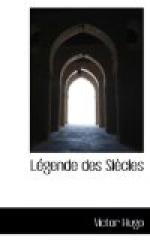One of the most marked features of Hugo’s poetry is his custom of attributing human desires and volition to inanimate objects. To Hugo, the whole universe seemed to be alive, both as a whole and in each of its separate parts, and his way of humanizing the inanimate is not so much a conscious literary artifice as the natural habit of his imagination. The tendency is not confined to his poetry; readers of his romances will remember the gargoyles of Notre-Dame and the cannon which got loose in the hold of the Claymore and became ’une bete surnaturelle.’ But the instances in his romantic poetry are naturally more numerous and more vivid. The swords of the heroes are always alive; in the duel between Roland and Olivier:
Durandal heurte et suit Closamont.
In the combat between Roland and his enemies in the Petit Roi de Galice, the hero staggers and Froila leaps forward to crush him:
Mais Durandal se dresse et jette Froila
Sur Pacheco, dont l’ame en ce moment
hurla.
The statues in the hall at Final are moved at the gentle tread of Fabrice and his little ward, and seem to bow to them as they pass.
Chaque statue, emue a leur pas doux et
sombre,
Vibre, et toutes ont l’air de saluer
dans l’ombre,
Les heros le vieillard, et les anges l’enfant.
But the most striking instance of this tendency occurs in Eviradnus, where, from beginning to end, all that surrounds the actors in the story lives with a passionate life. The trees that overhear the plot of Sigismond and Ladislas tremble and moan, and the words that issue from the lips of the miscreants are dark with shadow or red with blood. The half-ruined castle of Corbus fights with the winter, like a strong man with his enemies; the gargoyles on its towers bark at the winds, the graven monsters on the ramparts snarl and snort, the sculptured lions claw and bite the wind and rain[4]. In the gloomy halls the griffins seize with their teeth the great beams of the roofs, and the door is afraid of the noise of its own opening. The very shadows feel fear and the pillars are chilled with terror. The armour of the horses and the men is terribly alive, and charger and knight make but one monster, clothed in scales of steel.




